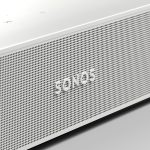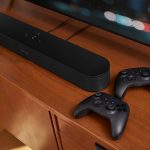

Sonos Beam Gen 2 with Dolby Atmos: price, release date, features | Ars Technica
source link: https://arstechnica.com/gadgets/2021/09/sonos-beam-gen-2-dolby-atmos-announced/
Go to the source link to view the article. You can view the picture content, updated content and better typesetting reading experience. If the link is broken, please click the button below to view the snapshot at that time.

Mini Atmos Bar —
The second-gen Sonos Beam soundbar arrives with Dolby Atmos, $50 price hike
Improved mini soundbar comes after price increases across the Sonos lineup.
Jeff Dunn - 9/14/2021, 1:18 PM
-
The second-generation Sonos Beam soundbar. It comes in white or black.
-
The big addition is Dolby Atmos virtual surround sound support.
-
The design is largely similar to the previous model, though the speaker grille now has a perforated plastic finish instead of a fabric-coated one. Sonos claims this will make it easier to clean over time.
-
Like all Sonos devices, the Beam is meant to be controlled primarily via the Sonos app, but there are basic capacitive touch controls on the top of the device.
-
The port selection is still limited, however, with just an Ethernet jack and an HDMI eARC port. It's a relatively simple soundbar to use, but it's generally aimed more toward casual Sonos users than those with more intricate home theater setups.
-
The first-generation Sonos Beam smart soundbar, for reference.
Sonos on Tuesday announced a new model of its Beam smart soundbar.
The Sonos Beam (Gen 2), as it’s called, doesn’t change much from its three-year-old predecessor from a conceptual standpoint. Sonos is still positioning the device as a lower-cost and far more compact alternative to its higher-end Arc soundbar, one that’s better suited to smaller rooms or secondary TVs. It‘s virtually the same size as before (25.63 x 3.94 x 2.72 in. and 6.2 lbs.) with a nearly identical minimalist design, though the fabric-coated front of the first-gen model has been stripped away in favor of a naked, perforated plastic grille that wraps around the device. Sonos says the new grille will be easier to clean over time.The big addition here is support for Dolby Atmos virtual surround sound. Notably, the Beam (Gen 2) uses the same internal acoustic architecture as before—including five class-D amplifiers, four mid-woofers, three passive radiators, and a center tweeter, but no up-firing speakers to physically create the illusion of audio “height” Atmos promises. But Sonos says the new model is equipped with a faster CPU, allowing it to improve the software that coordinates the soundbar’s audio output and steer it around a room. There are two new virtual "speaker arrays" for height and surround audio information; the setup will help Atmos content still sound as if it’s coming from above and around your head in addition to the usual left, center, and right channels.
It’s tough to say how effective the system is without hearing the new Beam in the wild, though. The original model had a nicely balanced sound that played decently loud for its conveniently compact size (if not its price), but it was a small soundbar, so it had to fight physics. It couldn’t get terribly deep in terms of sub-bass, for instance. Presumably, this kind of hardware can only provide so much of that spacious, immersive sound that makes Atmos work, but we’ve yet to hear the device for ourselves, and supporting the format on some level is better than not having it at all in terms of future-proofing. Sonos says it will also add support for DTS Digital Surround audio "later this year" to all soundbars using its Sonos S2 app, the new Beam included.
Beyond that, the HDMI-ARC port on the old Beam—which allows for more unified connectivity through your TV—is now a higher-bandwidth eARC port. Having other HDMI 2.1 devices in your home theater should help lessen audio syncing issues. The port selection on the whole is still limited to just HDMI and an Ethernet jack, however. There’s now 802.11ac dual-band Wi-Fi instead of basic 802.11n, though, as well as NFC support for an ostensibly quicker setup process. Apple’s AirPlay 2 protocol is still there for beaming audio directly from iOS devices, and you can set the device up with either Amazon’s Alexa or the Google Assistant. Sonos’ nifty “TruePlay” feature, which corrects its speakers’ sound for the acoustics of a given room, is also onboard. The company says the new Beam will support higher-res audio formats from Amazon Music’s “Ultra HD” tier and Dolby’s Atmos Music format as well.
AdvertisementUnfortunately, the new Beam comes with a new price: it’ll cost $449 when it begins shipping on October 5, which is a $50 increase from the original model. This jump seems to be part of a sweeping set of price hikes from Sonos that took effect this week, which included a $100 bump to the Arc (now priced at $899) and $10-50 increases to many of its portable and home speakers. The company said it is “always assessing market dynamics,” including component costs and supply and demand factors, in a statement last week to The Verge regarding the reasons for the price hikes.
That increase will likely hurt the Beam’s value proposition, as there were already numerous soundbars that could provide comparable, if not more expansive, sound for less than the original model’s price. In the end, though, the reasons to consider the Beam will likely remain unchanged: if you’ve already invested in a Sonos system and either can’t afford or fit the more traditionally Atmos-ready Arc into your home theater setup—or if you just want a compact and clean-sounding soundbar, are willing to pay a premium for easier-than-usual operation and music streaming thanks to the handy Sonos app, and don’t mind the sparse port selection—the second-gen Beam may still be worth keeping an eye on, particularly if it can handle Atmos effectively.
Note: Ars Technica may earn compensation for sales from links on this post through affiliate programs.
Listing image by Sonos
Recommend
About Joyk
Aggregate valuable and interesting links.
Joyk means Joy of geeK


